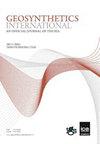Uniaxial compression test of cement-solidified dredged slurry columns encased with geogrid
IF 3.3
2区 工程技术
Q2 ENGINEERING, GEOLOGICAL
引用次数: 0
Abstract
This study investigated the performance of unreinforced and geogrid-encased cement-stabilized dredged slurry columns by uniaxial compression tests to simulate the extreme case where the surrounding soil offers no confinement. The objective was to understand the strength characteristics and visualize the deformation damage patterns of the columns with respect to the water content, cement content, length-to-diameter ratio, and geogrid strength. The results show that the unreinforced specimens exhibited strain-softening behavior, whereas geogrid encasement induced strain-hardening, with high-strength geogrids showing superior strain-hardening capacity. Notably, regardless of geogrid strength, encasement enhanced the resistance to deformation and ductility of the columns. Increasing the cement content, reducing the water content, and decreasing the length-to-diameter ratio all contributed to higher peak strength in both unreinforced and geogrid-encased specimens. Geogrid encasement provides confinement that enhances peak strength. The influence of geogrid encasement on peak strength becomes more pronounced at lower cement contents, higher water contents, and higher length-to-diameter ratios. Geogrid encasement also affects failure modes, altering the predominant inclined shear failure observed at the top of unreinforced specimens. Specimens encased with geogrids of higher tensile strength exhibit enhanced integrity and deformation resembling compression strut buckling, with a symmetrically inclined failure trend at the top and bottom.用土工格栅包裹水泥固化疏浚泥浆柱的单轴压缩试验
本研究通过单轴压缩试验,模拟周围土壤不提供约束的极端情况,研究了无加固水泥稳定疏浚泥浆柱和土工格栅包裹水泥稳定疏浚泥浆柱的性能。目的是了解柱子的强度特征,并观察柱子的变形破坏模式与含水量、水泥含量、长径比和土工格栅强度的关系。结果表明,未加固的试样表现出应变软化行为,而土工格栅包裹则引起应变硬化,其中高强度土工格栅表现出更强的应变硬化能力。值得注意的是,无论土工格栅的强度如何,包裹都能增强柱子的抗变形能力和延展性。增加水泥含量、减少含水量和降低长径比都有助于提高未加固试样和土工格栅包裹试样的峰值强度。土工格栅包裹提供的约束增强了峰值强度。在水泥含量较低、含水量较高和长径比较大的情况下,土工格栅包裹对峰值强度的影响更加明显。土工格栅包裹也会影响破坏模式,改变在未加固试样顶部观察到的主要倾斜剪切破坏模式。用抗拉强度较高的土工格栅包裹的试样显示出更强的完整性和类似于压缩支柱屈曲的变形,顶部和底部呈对称的倾斜破坏趋势。
本文章由计算机程序翻译,如有差异,请以英文原文为准。
求助全文
约1分钟内获得全文
求助全文
来源期刊

Geosynthetics International
ENGINEERING, GEOLOGICAL-GEOSCIENCES, MULTIDISCIPLINARY
CiteScore
6.90
自引率
20.00%
发文量
91
审稿时长
>12 weeks
期刊介绍:
An online only, rapid publication journal, Geosynthetics International – an official journal of the International Geosynthetics Society (IGS) – publishes the best information on current geosynthetics technology in research, design innovation, new materials and construction practice.
Topics covered
The whole of geosynthetic materials (including natural fibre products) such as research, behaviour, performance analysis, testing, design, construction methods, case histories and field experience. Geosynthetics International is received by all members of the IGS as part of their membership, and is published in e-only format six times a year.
 求助内容:
求助内容: 应助结果提醒方式:
应助结果提醒方式:


